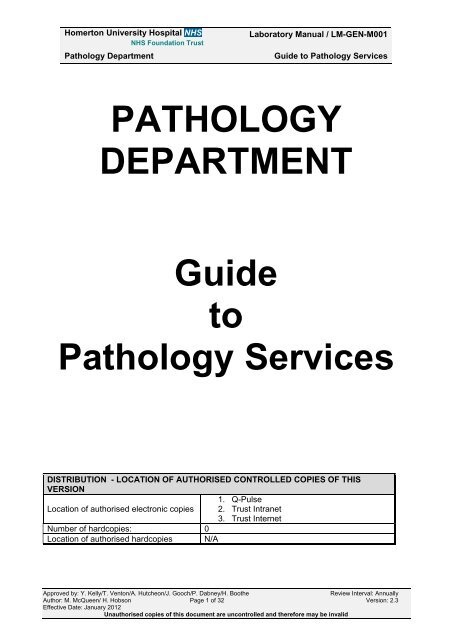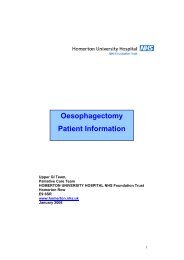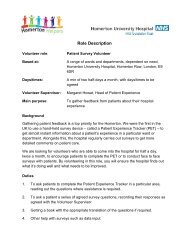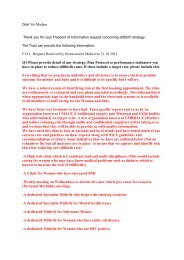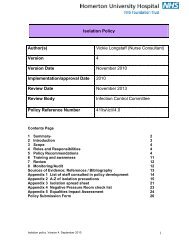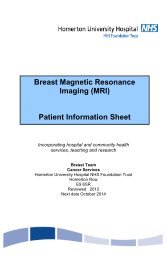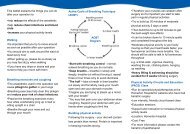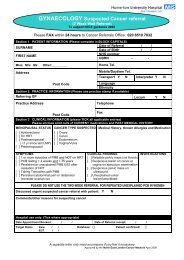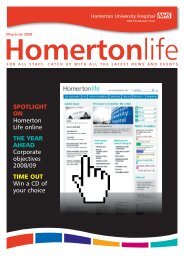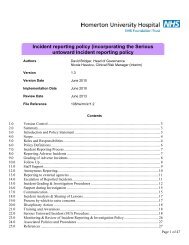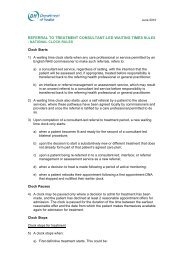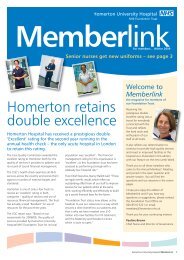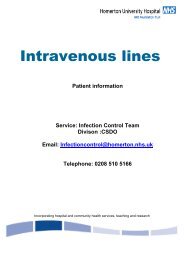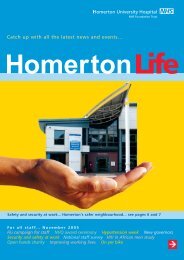PATHOLOGY DEPARTMENT Guide to Pathology Services
PATHOLOGY DEPARTMENT Guide to Pathology Services
PATHOLOGY DEPARTMENT Guide to Pathology Services
Create successful ePaper yourself
Turn your PDF publications into a flip-book with our unique Google optimized e-Paper software.
Homer<strong>to</strong>n University Hospital NHSNHS Foundation Trust<strong>Pathology</strong> DepartmentLabora<strong>to</strong>ry Manual / LM-GEN-M001<strong>Guide</strong> <strong>to</strong> <strong>Pathology</strong> <strong>Services</strong><strong>PATHOLOGY</strong><strong>DEPARTMENT</strong><strong>Guide</strong><strong>to</strong><strong>Pathology</strong> <strong>Services</strong>DISTRIBUTION - LOCATION OF AUTHORISED CONTROLLED COPIES OF THISVERSION1. Q-PulseLocation of authorised electronic copies 2. Trust Intranet3. Trust InternetNumber of hardcopies: 0Location of authorised hardcopies N/AApproved by: Y. Kelly/T. Ven<strong>to</strong>n/A. Hutcheon/J. Gooch/P. Dabney/H. BootheReview Interval: AnnuallyAuthor: M. McQueen/ H. Hobson Page 1 of 32 Version: 2.3Effective Date: January 2012Unauthorised copies of this document are uncontrolled and therefore may be invalid
Homer<strong>to</strong>n University Hospital NHSNHS Foundation Trust<strong>Pathology</strong> DepartmentLabora<strong>to</strong>ry Manual / LM-GEN-M001<strong>Guide</strong> <strong>to</strong> <strong>Pathology</strong> <strong>Services</strong>TABLE OF CONTENTS1 INTRODUCTION......................................................................................................................... 42 <strong>PATHOLOGY</strong> LOCATION AND ACCESS................................................................................. 42.1 Opening Times & on-call service ....................................................................................................43 KEY PERSONNEL/CONTACT NUMBERS................................................................................ 53.1 <strong>Pathology</strong> complaints or Comments ...............................................................................................64 <strong>PATHOLOGY</strong> REQUESTS......................................................................................................... 64.1 Ordering via Electronic Patient Record (EPR)................................................................................64.2 Ordering via Request Form.............................................................................................................74.3 Blood grouping and cross match requests .....................................................................................74.4 Self-adhesive addressograph labels...............................................................................................74.5 Additional test requests...................................................................................................................84.6 Urgent Requests .............................................................................................................................85 <strong>PATHOLOGY</strong> RESULTS............................................................................................................ 86 SPECIMEN TRANSPORTATION............................................................................................... 86.1 External Specimen transport...........................................................................................................86.2 Internal Specimen Transport...........................................................................................................96.3 Leaking or contaminated specimens ............................................................................................106.4 S<strong>to</strong>rage of Specimens during out-of-hours (non-urgent) ..............................................................106.5 Blood culture bottles .....................................................................................................................107 HAEMATOLOGY...................................................................................................................... 117.1 Contact details of Key members of staff .......................................................................................117.2 Location.........................................................................................................................................117.3 <strong>Services</strong> provided by the Haema<strong>to</strong>logy ........................................................................................117.4 Anticoagulant advice and dosing ..................................................................................................127.5 Point-of-Care Testing (POCT) ......................................................................................................127.6 Time limit for requesting additional examinations.........................................................................128 BLOOD TRANSFUSION SERVICES ....................................................................................... 138.1 Contact details of Key members of staff .......................................................................................138.2 Location.........................................................................................................................................138.3 Provision of Blood & Blood Products ............................................................................................138.4 Turnaround Time (TAT) for Emergency Blood .............................................................................148.5 Transfusion reactions....................................................................................................................148.6 Time limits for requesting additional examinations.......................................................................149 CLINICAL BIOCHEMISTRY..................................................................................................... 159.1 Contact details of Key members of staff .......................................................................................159.2 Location.........................................................................................................................................159.3 Quality control ...............................................................................................................................159.4 24-hour urine collection procedures .............................................................................................169.5 Random urine samples .................................................................................................................169.6 Faeces ..........................................................................................................................................169.7 Fasting Blood Requests................................................................................................................169.8 Miscellaneous body fluids .............................................................................................................169.9 Cerebrospinal fluid ........................................................................................................................169.10 Point-of-Care Testing (POCT) ......................................................................................................179.11 Aminoglycoside Antibiotic Moni<strong>to</strong>ring ...........................................................................................179.12 Time limits for requesting additional examinations.......................................................................1710 MICROBIOLOGY...................................................................................................................... 1810.1 Contact details of Key members of staff .......................................................................................1810.2 Clinical advice ...............................................................................................................................1810.3 Location.........................................................................................................................................1810.4 Test information ............................................................................................................................1810.5 Specimen collection specific requirements...................................................................................1910.6 General guidelines on specimen collection: .................................................................................1910.7 Turnaround Times (TAT) ..............................................................................................................2010.8 INFECTION CONTROL ................................................................................................................20Approved by: Y. Kelly/T. Ven<strong>to</strong>n/A. Hutcheon/J. Gooch/P. Dabney/H. BootheReview Interval: AnnuallyAuthor: M. McQueen/ H. Hobson Page 2 of 32 Version: 2.3Effective Date: January 2012Unauthorised copies of this document are uncontrolled and therefore may be invalid
Homer<strong>to</strong>n University Hospital NHSNHS Foundation Trust<strong>Pathology</strong> DepartmentLabora<strong>to</strong>ry Manual / LM-GEN-M001<strong>Guide</strong> <strong>to</strong> <strong>Pathology</strong> <strong>Services</strong>10.9 Aminoglycoside antibiotic moni<strong>to</strong>ring............................................................................................2110.10 Molecular Microbiology Service ....................................................................................................2110.11 Time limits for requesting additional examinations.......................................................................2111 HISTO<strong>PATHOLOGY</strong> AND CYTOLOGY .................................................................................. 2211.1 Specimen collection and preservation ..........................................................................................2211.2 Routine specimens .......................................................................................................................2211.3 Routine turnaround Times (TAT) ..................................................................................................2211.4 Frozen Sections ............................................................................................................................2211.5 Cy<strong>to</strong>logy ........................................................................................................................................2311.6 Urgent Requests ...........................................................................................................................2312 <strong>PATHOLOGY</strong> STORES............................................................................................................ 2313 POINT OF CARE TESTING (POCT) ........................................................................................ 2313.1 Key Contact details .......................................................................................................................2313.2 Clinical Advice and Interpretation .................................................................................................2313.3 Service provided by <strong>Pathology</strong> for the support of POCT..............................................................2413.4 Training .........................................................................................................................................2413.5 Supported POCT devices .............................................................................................................2414 TEST CODES, TEST NAME AND SPECIAL REQUIREMENTS. ............................................ 2615 NAMES & ADDRESSES OF REFERRAL LABORATORIES.................................................. 32Approved by: Y. Kelly/T. Ven<strong>to</strong>n/A. Hutcheon/J. Gooch/P. Dabney/H. BootheReview Interval: AnnuallyAuthor: M. McQueen/ H. Hobson Page 3 of 32 Version: 2.3Effective Date: January 2012Unauthorised copies of this document are uncontrolled and therefore may be invalid
Homer<strong>to</strong>n University Hospital NHSNHS Foundation Trust<strong>Pathology</strong> DepartmentLabora<strong>to</strong>ry Manual / LM-GEN-M001<strong>Guide</strong> <strong>to</strong> <strong>Pathology</strong> <strong>Services</strong>1 IntroductionThe information contained in this User <strong>Guide</strong> has been developed in conjunction with our Users inorder <strong>to</strong> meet their needs and requirements. This document provides detailed information aboutthe diagnostic pathology service at Homer<strong>to</strong>n University Hospital NHS Foundation Trust and wehope that it will enable you <strong>to</strong> make the most efficient use of the service. If you have any questionsor require information about the service provided by a specific labora<strong>to</strong>ry, please contact thelabora<strong>to</strong>ry directly and ask for advice from a Pathologist or a Senior Biomedical Scientist.The <strong>Pathology</strong> Department at Homer<strong>to</strong>n University NHS Foundation Trust provides acomprehensive diagnostic service for the following <strong>Pathology</strong> disciplines:Clinical Biochemistry (incorporating selected viral serology tests, Vitamin D section andSerum Electrophoresis, Point of Care Testing)Haema<strong>to</strong>logy and Blood Transfusion (incorporating Point of Care Testing)Microbiology including infection control services and the Molecular Labora<strong>to</strong>rySpecimens for His<strong>to</strong>pathology, Cy<strong>to</strong>logy, Virology and Immunology are processed by the<strong>Pathology</strong> Specimen reception and forwarded <strong>to</strong> referral labora<strong>to</strong>ries for analysis.2 <strong>Pathology</strong> Location and AccessThe <strong>Pathology</strong> Department at Homer<strong>to</strong>n University Hospital NHS Foundation Trust is a wellequipped facility located on the ground and first floors in the Green Zone of the main HospitalBuilding. Visi<strong>to</strong>rs <strong>to</strong> <strong>Pathology</strong> should report <strong>to</strong> the <strong>Pathology</strong> Reception, on the first floor, whichcan be found via the Main Hospital entrance and following the signs for <strong>Pathology</strong>.Access <strong>to</strong> the department is only given <strong>to</strong> Trust Staff wearing ID badges and for pre-arrangedvisi<strong>to</strong>rs.2.1 Opening Times & on-call serviceThe <strong>Pathology</strong> labora<strong>to</strong>ries operate 24 hours a day, 7 days a week, and 365 days a year.The <strong>Pathology</strong> department is open for receipt and processing of routine specimens during thehours stated below. Outside of these hours an on-call service is provided by experiencedBiomedical Scientists.Department Monday-Friday Saturday Sunday / On-call serviceBank Holiday<strong>Pathology</strong>0800 – 18.30 09.00 – 13.00 09.00 – 13.00 N/AReceptionClinical09.00 – 20.00 On-call service On-call service Bleep 233BiochemistryHaema<strong>to</strong>logy & 08.00 – 20.00 On-call service On-call Service Bleep 234Blood TransfusionMicrobiology 09.00 – 17.30 09.00 – 13.00 On-call Service Contact on call staffvia switch boardApproved by: Y. Kelly/T. Ven<strong>to</strong>n/A. Hutcheon/J. Gooch/P. Dabney/H. BootheReview Interval: AnnuallyAuthor: M. McQueen/ H. Hobson Page 4 of 32 Version: 2.3Effective Date: January 2012Unauthorised copies of this document are uncontrolled and therefore may be invalid
Homer<strong>to</strong>n University Hospital NHSNHS Foundation Trust<strong>Pathology</strong> DepartmentLabora<strong>to</strong>ry Manual / LM-GEN-M001<strong>Guide</strong> <strong>to</strong> <strong>Pathology</strong> <strong>Services</strong>3 Key Personnel/Contact Numbers<strong>Pathology</strong> DepartmentTel number /bleepBlood Transfusion Labora<strong>to</strong>ry 020 8510 7894Blood Transfusion Fax 020 8510 7895Blood Transfusion Manager: Hugh Boothe 0208 510 7213Transfusion Practitioner Evodian Fonyonga 020 8510 5089 / Bleep 836Clinical Biochemistry Labora<strong>to</strong>ry 020 8510 7887 / 7888Clinical Biochemistry Labora<strong>to</strong>ry Manager: Tim Ven<strong>to</strong>n 020 8510 7235Clinical Biochemistry Drugs of Abuse labora<strong>to</strong>ry 020 8510 7189Consultant Clinical Biochemist: Mr P Timms 020 8510 7886Haema<strong>to</strong>logy Labora<strong>to</strong>ry 020 8510 7892Haema<strong>to</strong>logy Labora<strong>to</strong>ry Manager: Yvonne Kelly 020 8510 7213Consultant Haema<strong>to</strong>logist Dr R AmosConsultant Haema<strong>to</strong>logist Dr M Evans020 8510 7300 / Air Call020 8510 5021 / Air CallHaema<strong>to</strong>logy Registrar 020 8510 7836 / Bleep 726IT Manager : John Gooch 020 8510 5010 / bleep 284Microbiology Labora<strong>to</strong>ry 020 8510 7187Microbiology Labora<strong>to</strong>ry Manager : Anne Hutcheon 020 8510 7184Consultant Microbiologist Dr D KrahéConsultant Microbiologist (DIPC) Dr A Clax<strong>to</strong>n020 8510 7181 / Air Call020 8510 7180 / Air CallMicrobiology Specialist Registrar 020 8510 5143 / Bleep 092Advanced Practitioner : Tony Ashcroft 020 8510 7185<strong>Pathology</strong> S<strong>to</strong>res 020 8510 7812POCT Coordina<strong>to</strong>r: Karen Stade 020 8510 7891 / bleep 370Quality Manager : Helen Hobson 020 8510 7503<strong>Pathology</strong> Specimen Reception 020 8510 7889 / 7898 / 7899 / 7892<strong>Pathology</strong> Specimen Reception Fax 020 8510 7555Approved by: Y. Kelly/T. Ven<strong>to</strong>n/A. Hutcheon/J. Gooch/P. Dabney/H. BootheReview Interval: AnnuallyAuthor: M. McQueen/ H. Hobson Page 5 of 32 Version: 2.3Effective Date: January 2012Unauthorised copies of this document are uncontrolled and therefore may be invalid
Homer<strong>to</strong>n University Hospital NHSNHS Foundation Trust<strong>Pathology</strong> DepartmentLabora<strong>to</strong>ry Manual / LM-GEN-M001<strong>Guide</strong> <strong>to</strong> <strong>Pathology</strong> <strong>Services</strong>3.1 <strong>Pathology</strong> complaints or CommentsThe <strong>Pathology</strong> Department welcomes feedback from our service users. Should you wish <strong>to</strong>contact <strong>Pathology</strong> <strong>to</strong> lodge a complaint or comment, please contact Helen Hobson, <strong>Pathology</strong>Quality Manager, via telephone on 020 8510 7503 or via email: Helen.Hobson@homer<strong>to</strong>n.nhs.uk.We will endeavour <strong>to</strong> respond <strong>to</strong> your concerns as soon as possible.4 <strong>Pathology</strong> RequestsIt is the responsibility of the requesting doc<strong>to</strong>r completing the request form or specimen label <strong>to</strong>ensure that sufficient information is provided and all information is correct, even if these duties aredelegated. The onus is not on the labora<strong>to</strong>ry <strong>to</strong> make assumptions about the origins or nature ofspecimens or the accuracy of any given details. If the information given is inadequate <strong>to</strong> processthe request then delays may occur or the request may be rejected/ returned <strong>to</strong> the sender. Everyeffort will be made <strong>to</strong> ensure that specimens are processed correctly and that vital specimens arenot discarded, but in the event of doubt as <strong>to</strong> the integrity of the information provided or the sourceof a specimen it will be destroyed.Each specimen must be collected in the correct container, if you do not have details or are unsureof which container <strong>to</strong> use, please refer <strong>to</strong> the guide at the back of this document or contact thelabora<strong>to</strong>ry directly.4.1 Ordering via Electronic Patient Record (EPR)All hospital patient requests, both inpatient and outpatient should be made via the EPRsystem. See EPR Training manuals, available on the intranet for instructions on how <strong>to</strong> order testsvia EPR. In the unusual event that EPR is not available please refer <strong>to</strong> the contingencyprocedures for EPR system failure (available on the intranet.)Note that specimens sent <strong>to</strong> the Blood Transfusion Labora<strong>to</strong>ry for Blood Grouping andCrossmatch have special labelling requirements. Please see section 4.3 below.All specimens must be appropriately labelled with:Patient’s Surname and Forename (or unique identifier)Hospital Number (if known) or NHS NumberDate of birthDate and time of specimen collectionOnly one EPR label should be affixed <strong>to</strong> each specimen container. The number of labels producedindicates the number of specimens <strong>to</strong> be taken.Particular care should be taken with microbiology specimens <strong>to</strong> ensure the correct label isattached <strong>to</strong> the correct specimen type.Approved by: Y. Kelly/T. Ven<strong>to</strong>n/A. Hutcheon/J. Gooch/P. Dabney/H. BootheReview Interval: AnnuallyAuthor: M. McQueen/ H. Hobson Page 6 of 32 Version: 2.3Effective Date: January 2012Unauthorised copies of this document are uncontrolled and therefore may be invalid
Homer<strong>to</strong>n University Hospital NHSNHS Foundation Trust<strong>Pathology</strong> DepartmentLabora<strong>to</strong>ry Manual / LM-GEN-M001<strong>Guide</strong> <strong>to</strong> <strong>Pathology</strong> <strong>Services</strong>4.2 Ordering via Request FormHard copy request forms may be used by General Practitioners, Health Care Centres and otherpathology users external <strong>to</strong> the Trust. Emergency Manual <strong>Pathology</strong> Request Forms may be usedin the event of EPR system failure. See contingency procedures for EPR system failure (availableon the intranet).It is essential that the request form is correctly completed with sufficient information <strong>to</strong> allow forcorrect identification of the patient and source of the request, and clinical information, whenappropriate, <strong>to</strong> ensure appropriate interpretation and timely reporting of results.NB* Many tests require the age and sex of patients <strong>to</strong> interpret appropriate reference ranges.The following information must be completed on the request form:Patient’s surname & ForenameDate of Birth (not age)Hospital Number (if known) or NHS NumberDate and Time of specimen collectionDoc<strong>to</strong>r’s Address or LocationRelevant Medical His<strong>to</strong>ryCurrent or significant therapySpecimen SourceSpecimen Type4.3 Blood grouping and cross match requestsPatient ID is manda<strong>to</strong>ry and samples will not be accepted for these investigations unless correctlylabelled with:Patient’s Surname and ForenameDate of birth (DD/MM/YYYY)SexHospital number or NHS number.Requesting clinicianSourceBlood Transfusion Request forms / specimens must be signed and patient details onspecimens must be handwritten.Any specimens or forms which do not have the prerequisite identification will not beprocessed, the requesting clinician will be informed and the specimen(s) discarded.4.4 Self-adhesive addressograph labelsThese are accepted on request forms but are not permitted on specimen bottles and containers.Approved by: Y. Kelly/T. Ven<strong>to</strong>n/A. Hutcheon/J. Gooch/P. Dabney/H. BootheReview Interval: AnnuallyAuthor: M. McQueen/ H. Hobson Page 7 of 32 Version: 2.3Effective Date: January 2012Unauthorised copies of this document are uncontrolled and therefore may be invalid
Homer<strong>to</strong>n University Hospital NHSNHS Foundation Trust<strong>Pathology</strong> DepartmentLabora<strong>to</strong>ry Manual / LM-GEN-M001<strong>Guide</strong> <strong>to</strong> <strong>Pathology</strong> <strong>Services</strong>4.5 Additional test requestsThe relevant labora<strong>to</strong>ry should be contacted directly <strong>to</strong> add a test <strong>to</strong> a specimen already receivedin <strong>Pathology</strong>. There are certain tests that can not be added on <strong>to</strong> ‘old’, unsuitable or insufficientspecimens; - the reques<strong>to</strong>r will be advised of this when contacting the labora<strong>to</strong>ry. AdditionalClinical Biochemistry and Infectious serology tests on samples submitted for both in or out-patientsmay be requisitioned through using the dedicated electronic form, available on the Trust intranet: -(http://homer<strong>to</strong>nlife/_ci387aua_1.html.)4.6 Urgent RequestsAny urgent requests must be telephoned <strong>to</strong> the <strong>Pathology</strong> Reception and <strong>to</strong> the appropriatelabora<strong>to</strong>ry prior <strong>to</strong> being sent <strong>to</strong> the <strong>Pathology</strong> Department.All such requests should be marked as “URGENT”.5 <strong>Pathology</strong> ResultsHospital Patient ResultsResults are delivered electronically <strong>to</strong> the EPR system, <strong>to</strong> personalised In-Boxes of the requestingclinician and <strong>to</strong> the individual patient record, negating the need for the labora<strong>to</strong>ry <strong>to</strong> produce paperreports. Results are also available via the <strong>Pathology</strong> Ward Enquiry facility (WinPath) as soon asthey are validated. Please note that validated results are preliminary results and may change prior<strong>to</strong> the issue of the final report.Significantly abnormal results will be telephoned <strong>to</strong> the requesting doc<strong>to</strong>r, nurse or consultant’ssecretary as appropriate.External Patient resultsPrinted reports are returned <strong>to</strong> GP practices, health care centres and other external service userson a daily basis. For many GP practices results are also transmitted electronically.The <strong>Pathology</strong> IT Manager is available for assistance with all <strong>Pathology</strong> computer systems andenquiries. Access <strong>to</strong> Ward Enquiry can be gained by completing a request form for log on details(available on the intranet) and sending it <strong>to</strong> the <strong>Pathology</strong> IT Manager.6 Specimen TransportationAll samples should be transported <strong>to</strong> the labora<strong>to</strong>ry without undue delay. Each specimen must besealed in a separate specimen bag with the accompanying request form attached. The requestform should not be removed or placed in the same pocket as the specimen. It is the responsibilityof the requesting doc<strong>to</strong>r <strong>to</strong> ensure that the specimen reaches the labora<strong>to</strong>ry.6.1 External Specimen transportPublished courier routes are available for the transport of <strong>Pathology</strong> Specimens from GP practices,Health Centres and other external service users. Individual practices receiving this service shouldbe aware of the scheduled collection times.Approved by: Y. Kelly/T. Ven<strong>to</strong>n/A. Hutcheon/J. Gooch/P. Dabney/H. BootheReview Interval: AnnuallyAuthor: M. McQueen/ H. Hobson Page 8 of 32 Version: 2.3Effective Date: January 2012Unauthorised copies of this document are uncontrolled and therefore may be invalid
Homer<strong>to</strong>n University Hospital NHSNHS Foundation Trust<strong>Pathology</strong> DepartmentLabora<strong>to</strong>ry Manual / LM-GEN-M001<strong>Guide</strong> <strong>to</strong> <strong>Pathology</strong> <strong>Services</strong>If your practice is not on a courier service and you think it would help please contact us and we doour best <strong>to</strong> accommodate you.6.2 Internal Specimen Transport6.2.1 Pneumatic Sample Transfer / POD System (PSTS)The POD system provides a rapid delivery system for pathology specimens. Please use the PODsystem in preference <strong>to</strong> portering specimens, where available, especially outside normal workinghours. See below for specimens types that must not be sent using the POD system.POD stations are situated in the following areas:CLINIC AREALocation codeA&E 171ACU 1 322ACU 2 344ANC 252ASKE 343BLOOD CLINIC 263BRYNING 153CASS 173COX 342DEFOE 152DELIVERY SUITE 231DOSH 245EDITH-CAVELL 321GRAHAM 244HALLEY 331ITU 163LAMB 332LLOYD 323MDU 174PRIETSLEY 131SCBU/NICU 243STARLIGHT 261TEMPLAR 151THOMAS 141TURPIN 242Blood samples must be allowed <strong>to</strong> stand for 20 minutes prior <strong>to</strong> despatch through the PSTS<strong>to</strong> avoid haemolysis and invalid results.The following specimen types should NOT be transported <strong>to</strong> the <strong>Pathology</strong> labora<strong>to</strong>ries viathe POD system:Blood culturesBlood Gas samplesMicrobiology specimens (including swabs, fluids urine, sputum etc)His<strong>to</strong>logy specimensCy<strong>to</strong>logy specimensApproved by: Y. Kelly/T. Ven<strong>to</strong>n/A. Hutcheon/J. Gooch/P. Dabney/H. BootheReview Interval: AnnuallyAuthor: M. McQueen/ H. Hobson Page 9 of 32 Version: 2.3Effective Date: January 2012Unauthorised copies of this document are uncontrolled and therefore may be invalid
Homer<strong>to</strong>n University Hospital NHSNHS Foundation Trust<strong>Pathology</strong> DepartmentLabora<strong>to</strong>ry Manual / LM-GEN-M001<strong>Guide</strong> <strong>to</strong> <strong>Pathology</strong> <strong>Services</strong>POD System BreakdownIn the event of a fault in the system during normal working hours you should contact <strong>Pathology</strong>Reception. During out of hours you should contact the Hospital switchboard and ask for the clinicalsite manager.6.2.2 Hospital PortersThere are specimen collection rounds for departments without access <strong>to</strong> the POD system.Collection times from the wards and departments ensure that specimens are received in <strong>Pathology</strong>Reception at the following times:Monday – Friday: 8.00am, 9.00am, 11.15am, 1.30pm, 3.15pm and 4.30pmOutside these hours, please bleep the duty porter or log a request for sample collection via theCARPS system. All microbiology specimens, especially blood cultures should be sent or taken <strong>to</strong>pathology immediately.6.3 Leaking or contaminated specimensLeaking specimens or those showing signs of contamination will not be analysed. In thesecircumstances the requesting clinician will be contacted. Specimen porters, couriers and receptionstaff are all trained in what <strong>to</strong> do in the event of a spillage.6.4 S<strong>to</strong>rage of Specimens during out-of-hours (non-urgent)Wards and departments must not s<strong>to</strong>re specimens in refrigera<strong>to</strong>rs overnight or at weekends. Allspecimens should be sent <strong>to</strong> the <strong>Pathology</strong> Department with minimal delay.6.5 Blood culture bottlesBlood culture bottles should not be transported <strong>to</strong> the labora<strong>to</strong>ry via the POD system. Oncedelivered <strong>to</strong> the <strong>Pathology</strong> Department, there is a blood culture incuba<strong>to</strong>r in <strong>Pathology</strong> Receptionspecifically allocated for the s<strong>to</strong>rage of these samples, which is maintained at 37 o C. Thesesamples must not be placed in a refrigera<strong>to</strong>r.Approved by: Y. Kelly/T. Ven<strong>to</strong>n/A. Hutcheon/J. Gooch/P. Dabney/H. BootheReview Interval: AnnuallyAuthor: M. McQueen/ H. Hobson Page 10 of 32 Version: 2.3Effective Date: January 2012Unauthorised copies of this document are uncontrolled and therefore may be invalid
Homer<strong>to</strong>n University Hospital NHSNHS Foundation Trust<strong>Pathology</strong> DepartmentLabora<strong>to</strong>ry Manual / LM-GEN-M001<strong>Guide</strong> <strong>to</strong> <strong>Pathology</strong> <strong>Services</strong>7 Haema<strong>to</strong>logyA comprehensive list of available tests, with sample requirements and expected Turnaround timesare provided in section 14 of this guide.Majority of haema<strong>to</strong>logy tests are performed on Sarstdedt Monovette® tubes7.1 Contact details of Key members of staffHaema<strong>to</strong>logy Enquiries 020 8510 7892Haema<strong>to</strong>logy Labora<strong>to</strong>ry Manager: Yvonne Kelly 020 8510 7213Contact number / Bleep NumberConsultant Haema<strong>to</strong>logist Dr R AmosConsultant Haema<strong>to</strong>logist Dr M Evans020 8510 7300 / Air Call020 8510 5021 / Air CallHaema<strong>to</strong>logy Registrar 020 8510 7836 / Bleep 726On-call biomedical scientist Bleep 234The above consultants and registrar can be contacted for clinical advice and interpretation duringnormal working hours. Outside normal working hours please contact the on-call consultant viaswitchboard.7.2 LocationThe Haema<strong>to</strong>logy Labora<strong>to</strong>ry is located on the first floor of the <strong>Pathology</strong> Department in the GreenZone of Homer<strong>to</strong>n University Hospital NHS Foundation Trust.7.3 <strong>Services</strong> provided by the Haema<strong>to</strong>logyRoutine haema<strong>to</strong>logy service; blood counts, ESR’s, infectious mononucleosis and malariascreening and blood film examination.Coagulation service: coagulation screen, Lupus Anticoagulant, thrombophilia screen,anticoagulation dosing assessment.Haemoglobinopathy screening service: sickle cell & thalassaemia screening, identification ofabnormal variants, G6PD assay.Blood transfusion service includes ABO and Rh D grouping, antibody screening, Haemolyticdisease of the foetus and newborn screening, issuing blood components and blood products.Additional investigations; immunophenotyping, cy<strong>to</strong>genetics, bone marrow examination areavailable on request.Approved by: Y. Kelly/T. Ven<strong>to</strong>n/A. Hutcheon/J. Gooch/P. Dabney/H. BootheReview Interval: AnnuallyAuthor: M. McQueen/ H. Hobson Page 11 of 32 Version: 2.3Effective Date: January 2012Unauthorised copies of this document are uncontrolled and therefore may be invalid
Homer<strong>to</strong>n University Hospital NHSNHS Foundation Trust<strong>Pathology</strong> DepartmentLabora<strong>to</strong>ry Manual / LM-GEN-M001<strong>Guide</strong> <strong>to</strong> <strong>Pathology</strong> <strong>Services</strong>7.4 Anticoagulant advice and dosingThe labora<strong>to</strong>ry provides the results of coagulation tests <strong>to</strong> control anticoagulation therapy, andclinical advice is provided by the Consultant Haema<strong>to</strong>logists.7.5 Point-of-Care Testing (POCT)See section 13 of this guide.7.6 Time limit for requesting additional examinationsThe following additional tests may be added on<strong>to</strong> specimens already received in the labora<strong>to</strong>rywithin the times stated below:TestD-DimerBlood FilmReticulocytesIMSSickleG6PDTime limit from receipt of specimen in the labora<strong>to</strong>ry <strong>to</strong> add on test4 Hours4 Hours24 Hours7 days7 days7 daysPlease contact the labora<strong>to</strong>ry directly if you wish <strong>to</strong> add a test on<strong>to</strong> a specimen and labora<strong>to</strong>ry staffwill advise if this is possible.Approved by: Y. Kelly/T. Ven<strong>to</strong>n/A. Hutcheon/J. Gooch/P. Dabney/H. BootheReview Interval: AnnuallyAuthor: M. McQueen/ H. Hobson Page 12 of 32 Version: 2.3Effective Date: January 2012Unauthorised copies of this document are uncontrolled and therefore may be invalid
Homer<strong>to</strong>n University Hospital NHSNHS Foundation Trust<strong>Pathology</strong> DepartmentLabora<strong>to</strong>ry Manual / LM-GEN-M001<strong>Guide</strong> <strong>to</strong> <strong>Pathology</strong> <strong>Services</strong>8 Blood Transfusion servicesFor blood transfusion requesting and labelling requirements refer <strong>to</strong> section 4.3.Specimen requirements: Sarstdedt Monovette® EDTA KE- for Blood Transfusion 7.5mlAlthough the labora<strong>to</strong>ry will endeavour <strong>to</strong> meet all requests for blood transfusion at the time anddate requested, if the patient has atypical antibodies additional time may be required <strong>to</strong> providecompatible blood. In some cases, samples may need <strong>to</strong> be referred <strong>to</strong> the National Blood Servicelabora<strong>to</strong>ries.8.1 Contact details of Key members of staffContact number/Bleep NumberBlood Transfusion Enquiries 020 8510 7894Blood Transfusion Fax 020 8510 7895Blood Transfusion Manager: Hugh Boothe 0208 510 7213Transfusion Practitioner Evodian Fonyonga 020 8510 5089 / Bleep 836Consultant Haema<strong>to</strong>logist Dr R AmosConsultant Haema<strong>to</strong>logist Dr M Evans020 8510 7300 / Air Call020 8510 5021 / Air CallOn-call Biomedical Scientist Bleep 234The above consultants can be contacted for clinical advice and interpretation during normalworking hours. Outside normal working hours please contact the on-call consultant viaswitchboard.8.2 LocationThe Blood Transfusion Labora<strong>to</strong>ry is located on the first floor of the <strong>Pathology</strong> Department in theGreen Zone of Homer<strong>to</strong>n University Hospital NHS Foundation Trust.8.3 Provision of Blood & Blood ProductsRed blood cells routinely kept in s<strong>to</strong>ck.Fresh frozen plasma and cryoprecipitate routinely kept in s<strong>to</strong>ck.Platelets available on request only.Human albumin solution (4.5% and 20%) is kept in s<strong>to</strong>ckRecombinant fac<strong>to</strong>r VIIa available on request <strong>to</strong> the Consultant Haema<strong>to</strong>logistProthrombin Complex Concentrate (PCC) available on request <strong>to</strong> the ConsultantHaema<strong>to</strong>logistApproved by: Y. Kelly/T. Ven<strong>to</strong>n/A. Hutcheon/J. Gooch/P. Dabney/H. BootheReview Interval: AnnuallyAuthor: M. McQueen/ H. Hobson Page 13 of 32 Version: 2.3Effective Date: January 2012Unauthorised copies of this document are uncontrolled and therefore may be invalid
Homer<strong>to</strong>n University Hospital NHSNHS Foundation Trust<strong>Pathology</strong> DepartmentLabora<strong>to</strong>ry Manual / LM-GEN-M001<strong>Guide</strong> <strong>to</strong> <strong>Pathology</strong> <strong>Services</strong>8.4 Turnaround Time (TAT) for Emergency BloodThe minimum turnaround time for fully compatible blood is 30 MINUTES from the time the samplearrives in the Labora<strong>to</strong>ry <strong>to</strong> the labelling of the packs with the compatibility labels. This TAT maybe affected by the number of urgent requests received.In an urgent situation, please communicate the nature of the emergency clearly <strong>to</strong> bloodtransfusion staff and ensure a blood sample from the patient is delivered as soon as possibledirectly <strong>to</strong> the labora<strong>to</strong>ry.2 units of O Negative blood are available for immediate use in the Adult Blood Issue fridge1 unit of O Negative blood is available for immediate use in the Neonatal and Paediatric BloodIssue fridgeA further 2 units O Negative blood maybe issued from the blood transfusion departmentABO Rh (D) group compatible blood will be issued until fully compatible blood is available.Crossmatched blood will be held for 48 hours from the indicated time of transfusion, unless thelabora<strong>to</strong>ry is notified otherwise. Please refer <strong>to</strong> hospital transfusion policy for further details.Please note that if units of blood have been given, a further blood sample for compatibilitytesting is necessary after 72 hours.There is a legal requirement for the department <strong>to</strong> maintain 100% vein <strong>to</strong> veintraceability for all blood components.You must enter the date and time of the transfusion on the compatibility label at the endof every transfusion.The label must be returned through the pneumatic chute system <strong>to</strong> the labora<strong>to</strong>ry within8 hours post transfusion.8.5 Transfusion reactionsInformation on the immediate actions in the event of a suspected blood transfusion reaction can befound in the Hospital Blood Transfusion Policy.Please contact the labora<strong>to</strong>ry staff immediately who will provide further advice when necessary onext: 7894/7895 and /or the transfusion practitioner on ext 5089 or Bleep 8368.6 Time limits for requesting additional examinationsAdditional tests may be added on<strong>to</strong> specimens already received in the labora<strong>to</strong>ry within 24 hoursof the original receipt of the specimen.Approved by: Y. Kelly/T. Ven<strong>to</strong>n/A. Hutcheon/J. Gooch/P. Dabney/H. BootheReview Interval: AnnuallyAuthor: M. McQueen/ H. Hobson Page 14 of 32 Version: 2.3Effective Date: January 2012Unauthorised copies of this document are uncontrolled and therefore may be invalid
Homer<strong>to</strong>n University Hospital NHSNHS Foundation Trust<strong>Pathology</strong> DepartmentLabora<strong>to</strong>ry Manual / LM-GEN-M001<strong>Guide</strong> <strong>to</strong> <strong>Pathology</strong> <strong>Services</strong>9 Clinical BiochemistryA comprehensive list of available tests, sample requirements and expected turnaround times areprovided at the end of this document.The vast majority of biochemistry tests are performed on Sarstdedt Monovette® tubes9.1 Contact details of Key members of staffContact number/bleep numberClinical Biochemistry 020 8510 7887 / 7888Labora<strong>to</strong>ry Manager: Tim Ven<strong>to</strong>n 020 8510 7235Clinical Biochemistry Drugs of Abuse labora<strong>to</strong>ry 020 8510 7189Consultant Clinical Biochemist: Mr P Timms 020 8510 7886On-call biomedical scientist Bleep 233The above consultant biochemist can be contacted for clinical advice and interpretation duringnormal working hours. Outside normal working hours the on-call consultant biochemist can becontacted via the on-call biomedical scientist in the labora<strong>to</strong>ry.9.2 LocationThe Clinical Biochemistry Labora<strong>to</strong>ry is located on the ground floor of the <strong>Pathology</strong> Department inthe Green Zone of Homer<strong>to</strong>n University Hospital NHS Foundation Trust. The Clinical Biochemistrydepartment Serum electrophoresis (EPS) labora<strong>to</strong>ry is temporarily housed in a building adjacent <strong>to</strong>the <strong>Pathology</strong> Department.9.3 Quality controlIn order <strong>to</strong> maintain high standards of analysis the Clinical Biochemistry labora<strong>to</strong>ry participates innational quality control schemes and maintains its own internal system of quality control checks.To ensure the quality of specimens sent <strong>to</strong> the labora<strong>to</strong>ry:Blood taken for estimation of potassium, magnesium, AST and phosphate must not be left unseparatedovernight.Never tip blood from one tube in<strong>to</strong> another.Ensure special specimen requirements as stated at the end of this guide are adhered <strong>to</strong>Contact the department if any difficulties in interpretation occur, and do not just ignore resultswhich cannot be explained or are thought <strong>to</strong> be erroneous.Approved by: Y. Kelly/T. Ven<strong>to</strong>n/A. Hutcheon/J. Gooch/P. Dabney/H. BootheReview Interval: AnnuallyAuthor: M. McQueen/ H. Hobson Page 15 of 32 Version: 2.3Effective Date: January 2012Unauthorised copies of this document are uncontrolled and therefore may be invalid
Homer<strong>to</strong>n University Hospital NHSNHS Foundation Trust<strong>Pathology</strong> DepartmentLabora<strong>to</strong>ry Manual / LM-GEN-M001<strong>Guide</strong> <strong>to</strong> <strong>Pathology</strong> <strong>Services</strong>9.4 24-hour urine collection proceduresTo ensure that a representative sample is collected, patients should be instructed <strong>to</strong> collect 24 hoururine specimens in the following way:Discard the first early morning sample passed and note the time of passing.Collect all other urine passed during the next 24 hours, up <strong>to</strong> and including the next earlymorning collection.Keep bottle in a cool place and send <strong>to</strong> labora<strong>to</strong>ry as soon as possible after the collection iscompleted.Some investigations require a preservative <strong>to</strong> be added <strong>to</strong> the specimen bottle prior <strong>to</strong>commencement of the test. In most cases the preservative used is 1.0M hydrochloric acid. Allbottles containing a preservative are clearly marked as such.If creatinine clearance is required please contact the labora<strong>to</strong>ry. The department offers a derivedparameter estimated glomerular filtration rate (eGFR) which correlates with creatinine clearance.9.5 Random urine samplesAn aliquot of a random (usually early morning) urine is best collected in<strong>to</strong> plastic WHITE CAPPEDuniversal (Sterilin) bottles. NEVER use red capped Sterilin bottles for biochemical pathology.Random urines for osmolality should be accompanied by a sample for serum osmolality.9.6 FaecesA small sample of a random specimen is best put in a plastic, blue capped, (Sterilin) bottle. Foroccult blood detection it is advisable <strong>to</strong> send specimens collected on three consecutive days andnote dietary restrictions.9.7 Fasting Blood RequestsFasting blood samples are required for many dynamic function tests, lipid profiles, fasting bloodglucose, oral glucose <strong>to</strong>lerance test (GTT) and lac<strong>to</strong>se <strong>to</strong>lerance test (LTT). The patient shouldfast from 10pm until 8am the following morning. Water is permitted during this time.9.8 Miscellaneous body fluidsPleural fluids, ascetic fluids and fluids of unknown origin should be collected in<strong>to</strong> WHITE CAPPED(Sterilin) bottles.9.9 Cerebrospinal fluidCerebrospinal fluid (CSF) for protein estimation should be collected after the microbiology samples<strong>to</strong> minimise inadvertent contamination with blood. CSF samples for measurement of glucoseshould be collected in<strong>to</strong> fluoride oxalate tube and accompanied by a blood sample collected in<strong>to</strong> asimilar tube.Approved by: Y. Kelly/T. Ven<strong>to</strong>n/A. Hutcheon/J. Gooch/P. Dabney/H. BootheReview Interval: AnnuallyAuthor: M. McQueen/ H. Hobson Page 16 of 32 Version: 2.3Effective Date: January 2012Unauthorised copies of this document are uncontrolled and therefore may be invalid
Homer<strong>to</strong>n University Hospital NHSNHS Foundation Trust<strong>Pathology</strong> DepartmentLabora<strong>to</strong>ry Manual / LM-GEN-M001<strong>Guide</strong> <strong>to</strong> <strong>Pathology</strong> <strong>Services</strong>9.10 Point-of-Care Testing (POCT)See section 13 of this guide.9.11 Aminoglycoside Antibiotic Moni<strong>to</strong>ringThese antibiotics are increasingly being given as a single daily dose with moni<strong>to</strong>ring of serumlevels; 16 <strong>to</strong> 24 hours post dose administration. An in-house moni<strong>to</strong>ring service is available for thefollowing antibiotics:GentamicinVancomycinAmikacinThis service is available at all times including during on-call periods.For advice on antibiotic therapy moni<strong>to</strong>ring please contact the Microbiology Registrar orMicrobiology Consultant.9.12 Time limits for requesting additional examinationsAdditional tests may be added on<strong>to</strong> specimens already received in the labora<strong>to</strong>ry. This will bedependent on the additional tests required and availability of the specimen in the labora<strong>to</strong>ry.Please contact the labora<strong>to</strong>ry directly if you wish <strong>to</strong> add a test on<strong>to</strong> a specimen and labora<strong>to</strong>ry staffwill advise if this is possible. Additional Clinical Biochemistry and Infectious serology tests onsamples submitted for both in or out-patients may be requisitioned through using the dedicatedelectronic form, available on the Trust intranet: - (http://homer<strong>to</strong>nlife/_ci387aua_1.html.) Furtherguidance on timing limitations for retrospective analysis is available via the Trust intranet andinternet respectively: -ooIntranet: http://homer<strong>to</strong>nlife/uploaded_files/A-Z/<strong>Pathology</strong>/time_limits_for_requesting_additional_investigations.pdfInternet: http://www.homer<strong>to</strong>n.nhs.uk/our-services/pathology/guide-<strong>to</strong>-labora<strong>to</strong>ry-tests-anddirec<strong>to</strong>ryApproved by: Y. Kelly/T. Ven<strong>to</strong>n/A. Hutcheon/J. Gooch/P. Dabney/H. BootheReview Interval: AnnuallyAuthor: M. McQueen/ H. Hobson Page 17 of 32 Version: 2.3Effective Date: January 2012Unauthorised copies of this document are uncontrolled and therefore may be invalid
Homer<strong>to</strong>n University Hospital NHSNHS Foundation Trust<strong>Pathology</strong> DepartmentLabora<strong>to</strong>ry Manual / LM-GEN-M001<strong>Guide</strong> <strong>to</strong> <strong>Pathology</strong> <strong>Services</strong>10 MicrobiologyThe Microbiology Department is consultant-led and provides a comprehensive clinical microbiologyservice including Bacteriology, Parasi<strong>to</strong>logy, Serology, TB culture and Mycology. The departmentworks closely with the Hospital’s Infection Control team in the provision of a comprehensiveinfection control service.10.1 Contact details of Key members of staffMicrobiology Lab Enquiries 020 8510 7187Serology Lab Enquiries 020 8510 7186Molecular Lab Enquiries 020 8510 7588Microbiology Labora<strong>to</strong>ry Manager : Anne Hutcheon 020 8510 7184Contact number / bleep numberConsultant Microbiologist Dr D KrahéConsultant Microbiologist (DIPC) Dr A Clax<strong>to</strong>n020 8510 7181 / Air Call020 8510 7180 / Air CallMicrobiology Specialist Registrar 020 8510 5143 / Bleep 092Advanced Practi<strong>to</strong>ner : Tony Ashcroft 020 8510 7185On-call biomedical scientistContact via hospital switchboard10.2 Clinical adviceClinical and therapeutic advice, including the interpretation of results can be obtained from either ofthe Consultant Microbiologists (ext 7181/ 7180) or the Microbiology Registrar on bleep 092 or ext5143.10.3 LocationThe Microbiology Labora<strong>to</strong>ry is located on the ground floor of the <strong>Pathology</strong> Department in theGreen Zone of Homer<strong>to</strong>n University Hospital NHS Foundation Trust. The Molecular MicrobiologyLabora<strong>to</strong>ry is a purpose built building located between the mortuary and pharmacy facilities.10.4 Test informationFull test information and specimen requirements are shown at the back of this guide. It is essentialthat the full clinical details are provided <strong>to</strong> allow a meaningful interpretation of the result. Relevantclinical information should include:Name of the ana<strong>to</strong>mical site from which the specimen was collectedDetails of ana<strong>to</strong>mical therapy (current or intended)Details of any recent foreign travelApproved by: Y. Kelly/T. Ven<strong>to</strong>n/A. Hutcheon/J. Gooch/P. Dabney/H. BootheReview Interval: AnnuallyAuthor: M. McQueen/ H. Hobson Page 18 of 32 Version: 2.3Effective Date: January 2012Unauthorised copies of this document are uncontrolled and therefore may be invalid
Homer<strong>to</strong>n University Hospital NHSNHS Foundation Trust<strong>Pathology</strong> DepartmentLabora<strong>to</strong>ry Manual / LM-GEN-M001<strong>Guide</strong> <strong>to</strong> <strong>Pathology</strong> <strong>Services</strong>Date of onset and duration of illness (particularly for serology)Any relevant epidemiological information, e.g. occupation.10.5 Specimen collection specific requirementsThe most reliable and accurate results are obtained when an appropriate, well sampled specimen,in the appropriate container is delivered <strong>to</strong> the labora<strong>to</strong>ry promptly with the relevant clinicalinformation provided on the request form.10.6 General guidelines on specimen collection:All specimens must be sent in sterile containersAll swabs should be received in accordance <strong>to</strong> the following informationSpecimenContainer/ Swab/ Blood Commentsbottle(s)MRSA screen Red swab Dry swabAll body sites Black Swab (charcoal) Amies CharcoalVirology culture / PCRGreen SwabRed UPT tubesThese tubes can be obtainedfrom RLH Virology DepartmentPernasalPernasal swab thin twistedwire)Bordetella / whooping coughinvestigationBlood culture (adult) Paired bottles ( blue & mauve) 10ml whole blood in eachBlood Culture (paediatric) X 1 Bottle (yellow) 4 ml whole bloodTB blood X1 Bottle (black) 3-5ml whole blood ( must becollect from microbiology)Quantiferon (IGRA) Special three tube pack Obtain from Respira<strong>to</strong>ryMedicineT-Spot TB (IGRA)7.5ml Lithium Heparin tube(orange <strong>to</strong>p)Specimens should arrive in<strong>Pathology</strong> before 4pm onMonday <strong>to</strong> Thursday only.Serology Requests7.5ml Plain <strong>to</strong>p bottleMeningo/Pneumococcal PCR 2ml EDTA bottleAll other samplesSterile containerWhere appropriate, specimens should be obtained before antimicrobial agents have beenadministeredAlways send pus rather than a swab of the pus siteThe specimen taken should be representative of the disease processCare must be taken <strong>to</strong> avoid contamination of the specimen by micro-organisms normallyfound on the skin and mucous membranesApproved by: Y. Kelly/T. Ven<strong>to</strong>n/A. Hutcheon/J. Gooch/P. Dabney/H. BootheReview Interval: AnnuallyAuthor: M. McQueen/ H. Hobson Page 19 of 32 Version: 2.3Effective Date: January 2012Unauthorised copies of this document are uncontrolled and therefore may be invalid
Homer<strong>to</strong>n University Hospital NHSNHS Foundation Trust<strong>Pathology</strong> DepartmentLabora<strong>to</strong>ry Manual / LM-GEN-M001<strong>Guide</strong> <strong>to</strong> <strong>Pathology</strong> <strong>Services</strong>Sterile equipment and aseptic technique must be used for collecting specimens, particularlythose from normally sterile sitesMaterial must be transported promptly <strong>to</strong> the labora<strong>to</strong>ryPlease contact the labora<strong>to</strong>ry if advice is required on the best specimen <strong>to</strong> take.10.7 Turnaround Times (TAT)SPECIMENUrineMRSA screenAll other swabsCSFBlood CulturesTBFluids, Pus & TissuesMycologyFaeces, OCPWhooping coughC.difficileQuantifieron/ T-Spot TBSputumTAT1-3 days1-2 days2-5 days2-3 daysup <strong>to</strong> 5 daysup <strong>to</strong> 42 days2-3 daysup <strong>to</strong> 3 weeks3-5 days5-7 days1 day3-5 days1-3 daysSpecimens are regarded as high risk if taken from patients known <strong>to</strong> be infected with blood-borneagents such as Hepatitis B, C, and HIV or other serious infectious diseases such as tuberculosis ortyphoid or from patients at risk of being infected by one of these agents. These samples should beidentified in the clinical details.10.8 INFECTION CONTROLThe infection control team is available for advice on the management of patients, and proceduresrequired for the prevention of cross-infection, of patients and staff.In the first instance please contact the Infection Control Advisor, Dr Alleyna Clax<strong>to</strong>n on ext.7180Hospital Infection Control policies are available for reference in all clinical areas and on theHospital intranet system.Approved by: Y. Kelly/T. Ven<strong>to</strong>n/A. Hutcheon/J. Gooch/P. Dabney/H. BootheReview Interval: AnnuallyAuthor: M. McQueen/ H. Hobson Page 20 of 32 Version: 2.3Effective Date: January 2012Unauthorised copies of this document are uncontrolled and therefore may be invalid
Homer<strong>to</strong>n University Hospital NHSNHS Foundation Trust<strong>Pathology</strong> DepartmentLabora<strong>to</strong>ry Manual / LM-GEN-M001<strong>Guide</strong> <strong>to</strong> <strong>Pathology</strong> <strong>Services</strong>10.9 Aminoglycoside antibiotic moni<strong>to</strong>ringThese antibiotics are increasingly being given as a single daily dose with moni<strong>to</strong>ring of serumlevels; 14 <strong>to</strong> 18 hours post dose administration. An in-house moni<strong>to</strong>ring service is available for thefollowing antibiotics via the clinical biochemistry department:GentamicinVancomycinAmikacinThis service is available at all times including during on-call periods.For full advice on antibiotic therapy moni<strong>to</strong>ring please contact the Consultant Microbiologist.10.10 Molecular Microbiology ServiceThis labora<strong>to</strong>ry currently tests for Chlamydia Trachomatis and N. gonorrhoea using the dualnucleic acid amplification technique (NAAT) and is available for all hospital departments.The turnaround time for these tests is within 3-5 days.<strong>Pathology</strong> s<strong>to</strong>res supplies the sample taking kits:SampleCXS and urethralUrine (male)VaginalSample taking kitWet swab packsUPT packsPurple swab packAreas within the community (GPs, family planning and young people’s services) are tested at theRoyal London Hospital.10.11 Time limits for requesting additional examinationsAdditional tests may be added on<strong>to</strong> specimens already received in the labora<strong>to</strong>ry. This will bedependent on the additional tests required and availability of the specimen in the labora<strong>to</strong>ry.Please contact the labora<strong>to</strong>ry directly if you wish <strong>to</strong> add a test on<strong>to</strong> a specimen and labora<strong>to</strong>ry staffwill advise if this is possible. Additional Clinical Biochemistry and Infectious serology tests onsamples submitted for both in or out-patients may be requisitioned through using the dedicatedelectronic form, available on the Trust intranet: - (http://homer<strong>to</strong>nlife/_ci387aua_1.html.)Further guidance on timing limitations for retrospective analysis is available via the Trust intranetand internet respectively: -ooIntranet: http://homer<strong>to</strong>nlife/uploaded_files/A-Z/<strong>Pathology</strong>/time_limits_for_requesting_additional_investigations.pdfInternet: http://www.homer<strong>to</strong>n.nhs.uk/our-services/pathology/guide-<strong>to</strong>-labora<strong>to</strong>ry-tests-anddirec<strong>to</strong>ryApproved by: Y. Kelly/T. Ven<strong>to</strong>n/A. Hutcheon/J. Gooch/P. Dabney/H. BootheReview Interval: AnnuallyAuthor: M. McQueen/ H. Hobson Page 21 of 32 Version: 2.3Effective Date: January 2012Unauthorised copies of this document are uncontrolled and therefore may be invalid
Homer<strong>to</strong>n University Hospital NHSNHS Foundation Trust<strong>Pathology</strong> DepartmentLabora<strong>to</strong>ry Manual / LM-GEN-M001<strong>Guide</strong> <strong>to</strong> <strong>Pathology</strong> <strong>Services</strong>11 His<strong>to</strong>pathology and Cy<strong>to</strong>logyThese services are currently contracted through the Royal Hospital’s Trust. If you experience anydifficulty with access <strong>to</strong> results, please contact <strong>Pathology</strong> on 5010 or the his<strong>to</strong>pathology labora<strong>to</strong>ry0203246018011.1 Specimen collection and preservationGenerally all biopsies and surgical specimens are submitted for His<strong>to</strong>pathological examination. Inmost cases specimens should be placed in a formalin fixative, but some important specimens, e.g.lymph nodes and unusual tumours, may need <strong>to</strong> be received fresh and unfixed for specialinvestigations.11.2 Routine specimensThe tissue must be placed in an adequate sized container with at least five times its volume offixative. Specimens should be labelled with the following details:Patient’s Family NamePatient’s First NameHospital NumberSpecimen TypeThe specimen(s) must be accompanied by an accurately completed request form. Failure <strong>to</strong>provide adequate clinical information may mean that the His<strong>to</strong>pathologist reporting may find itnecessary <strong>to</strong> contact you, which will delay the issuing of a report.Please note: formalin-fixed tissue is unsuitable for bacteriological examination.If this is required please either send two separate pots or send fresh tissue but contact thelabora<strong>to</strong>ry immediately so that appropriate arrangements can be made <strong>to</strong> divide the specimen.11.3 Routine turnaround Times (TAT)Approximately 80% of urgent his<strong>to</strong>logy and non-gynaecological specimens are reported within fourworking days of receipt at the referral labora<strong>to</strong>ry.TAT for biopsies and other small specimens is between 48 – 72 hours.90% of non-urgent his<strong>to</strong>logy is reported within 7 working days although cases requiring longerfixation or special investigation may take longer. Gynaecological specimens take between 3 – 4weeks which corresponds <strong>to</strong> the national average.If results are required sooner, please contact a senior member of the Royal London labora<strong>to</strong>rystaff giving the clinical reasons for the urgency and contact the <strong>Pathology</strong> reception.11.4 Frozen SectionsRequests for frozen sections should be booked as early as possible. This isespecially important if a particular consultant is required <strong>to</strong> examine the specimen.Approved by: Y. Kelly/T. Ven<strong>to</strong>n/A. Hutcheon/J. Gooch/P. Dabney/H. BootheReview Interval: AnnuallyAuthor: M. McQueen/ H. Hobson Page 22 of 32 Version: 2.3Effective Date: January 2012Unauthorised copies of this document are uncontrolled and therefore may be invalid
Homer<strong>to</strong>n University Hospital NHSNHS Foundation Trust<strong>Pathology</strong> DepartmentLabora<strong>to</strong>ry Manual / LM-GEN-M001<strong>Guide</strong> <strong>to</strong> <strong>Pathology</strong> <strong>Services</strong>11.5 Cy<strong>to</strong>logySpecimens should be taken during normal working hours if possible. Specimens left inrefrigera<strong>to</strong>rs overnight are not satisfac<strong>to</strong>ry. Where possible take specimens early in the morning.Pleural and ascetic fluids (if available, at least 50ml) must be added <strong>to</strong> a container with sodiumcitrate <strong>to</strong> prevent clotting, since clotted specimens make unsatisfac<strong>to</strong>ry preparations. Thesecontainers can be obtained from the pathology s<strong>to</strong>res.The turnaround time for routine gynaecological cy<strong>to</strong>logy varies with workload but slides arenormally reported within 3 working days.11.6 Urgent RequestsUrgent requests can be processed and a report issued within hours, provided that the labora<strong>to</strong>ry isgiven adequate notice. Urgent samples should be sent <strong>to</strong> the labora<strong>to</strong>ry as soon as possible aftercollection.12 <strong>Pathology</strong> S<strong>to</strong>resThe <strong>Pathology</strong> s<strong>to</strong>res supplies a limited number of items <strong>to</strong> the Trust. GPs must obtain all itemsfrom the NHS supply chain on 01773 724255.All requests for supplies by the wards and departments must be submitted by fax <strong>to</strong> the <strong>Pathology</strong>Reception Fax number: 7555S<strong>to</strong>res opening times are Monday – Friday 09.00-17.30 (closed between 13.00-14.00)13 Point of Care Testing (POCT)Point of care testing is the analytical testing of a patient sample performed by a healthcareprofessional outside the conventional labora<strong>to</strong>ry setting. The pathology department is responsiblemanagement of the POCT service. It is vital that medical and nursing personnel are aware of theindividual(s) who have responsibility for both the results that are generated and the correct use ofthe equipment used <strong>to</strong> generate those results. New POCT devices should not be introducedwithout prior discussion with the <strong>Pathology</strong>. Please refer <strong>to</strong> the trust POCT Policy.13.1 Key Contact detailsPOCT Coordina<strong>to</strong>r: Karen StadeTelephone: 020 8510 7891Bleep: 370The POCT coordina<strong>to</strong>r can be contacted Monday <strong>to</strong> Friday from 9am <strong>to</strong> 5.30pm. Outside thesehours there is very limited support offered by the labora<strong>to</strong>ry and Medical Electronics departmentplease see individual equipment sections for information.13.2 Clinical Advice and InterpretationThe relevant pathology consultant can be contacted for clinical advice and interpretation duringnormal working hours. Outside normal working hours the on-call consultant can be contacted (seeApproved by: Y. Kelly/T. Ven<strong>to</strong>n/A. Hutcheon/J. Gooch/P. Dabney/H. BootheReview Interval: AnnuallyAuthor: M. McQueen/ H. Hobson Page 23 of 32 Version: 2.3Effective Date: January 2012Unauthorised copies of this document are uncontrolled and therefore may be invalid
Homer<strong>to</strong>n University Hospital NHSNHS Foundation Trust<strong>Pathology</strong> DepartmentLabora<strong>to</strong>ry Manual / LM-GEN-M001<strong>Guide</strong> <strong>to</strong> <strong>Pathology</strong> <strong>Services</strong>discipline specific information above). The POCT Coordina<strong>to</strong>r can also be contacted during normalworking hours as detailed above.13.3 Service provided by <strong>Pathology</strong> for the support of POCTThe POCT Coordina<strong>to</strong>r is happy <strong>to</strong> offer advice and guidance regarding training, safety and theprovision of a comprehensive quality control programme <strong>to</strong> ensure the accuracy and reliability ofthe equipment and the results produced. When the <strong>Pathology</strong> department agrees <strong>to</strong> support suchequipment it will be subject <strong>to</strong> the same accreditation process as that of the main labora<strong>to</strong>ry.13.4 TrainingAll POCT equipment should only be used by staff with documented training and competency.Please contact the POCT coordina<strong>to</strong>r <strong>to</strong> arrange training before using equipment. All analysersare supported by operating procedures and user guides which must be followed.13.5 Supported POCT devices13.5.1 Full Blood Count AnalyserLocation: A&EAnalyser: Beckman Coulter ACTI 5Diff analyserParameters: all main FBC parameters and a 5 part differential count.Maintenance: maintained daily by POCT Coordina<strong>to</strong>r/<strong>Pathology</strong> staffSpecimen Requirements: 2.7ml EDTA (Red Top) Adult specimens only (ensure specimen isnot clotted)Limitations: Should not be used on patients with known high white cell count (above 100 x10 9 /L). Send abnormal specimens <strong>to</strong> the Haema<strong>to</strong>logy labora<strong>to</strong>ry for confirmation. SeeAnalyser User guide for further information.Clinical Advice: See Haema<strong>to</strong>logy Consultant13.5.2 Arterial Blood gas Location: ITU, A&E, NNU, Delivery suite and the respira<strong>to</strong>ry unit. Areas without a blood gasanalyser may bring a heparinised specimen <strong>to</strong> the biochemistry labora<strong>to</strong>ry for analysis.Specimens with needles attached will not be accepted in the labora<strong>to</strong>ry. Analyser: IL GEM Premier 4000 Parameters: Full arterial Blood Gas analysis (additional analytes may be included dependan<strong>to</strong>n location of analyser) Maintenance: maintained by users. Trouble shooting is provided by the POCT coordina<strong>to</strong>rduring normal working hours. For out of hours support for NNU/Delivery suite contact MedicalElectronics. Specimen Requirements: Pre-heparinised syringe or capillary tube. Ensure specimens aremixed thoroughly prior <strong>to</strong> analysis. Expel air bubbles prior <strong>to</strong> analysis. Limitations: Do NOT use an un-heparinised specimen or one that has clotted. Clinical Advice: See Biochemistry ConsultantApproved by: Y. Kelly/T. Ven<strong>to</strong>n/A. Hutcheon/J. Gooch/P. Dabney/H. BootheReview Interval: AnnuallyAuthor: M. McQueen/ H. Hobson Page 24 of 32 Version: 2.3Effective Date: January 2012Unauthorised copies of this document are uncontrolled and therefore may be invalid
Homer<strong>to</strong>n University Hospital NHSNHS Foundation Trust<strong>Pathology</strong> DepartmentLabora<strong>to</strong>ry Manual / LM-GEN-M001<strong>Guide</strong> <strong>to</strong> <strong>Pathology</strong> <strong>Services</strong>13.5.3 Blood Glucose Moni<strong>to</strong>ringLocation: Trust WideAnalyser: Abbott Optium XceedParameter: Capillary Whole Blood GlucoseMaintenance: maintained by users. New batteries, troubleshooting and replacement of faultymeters available through the POCT Coordina<strong>to</strong>r.Specimen Requirements: Finger-prick capillary blood specimen. Do NOT use specimen fromFlu/Ox (yellow <strong>to</strong>p) tubeLimitations: Ensure patients hands are clean prior <strong>to</strong> finger-prick. Should not be used onpatients with very high or low haema<strong>to</strong>crit. Other patient groups may not be suitable foranalysis please refer <strong>to</strong> inserts for further information.Clinical Advice: See Biochemistry Consultant13.5.4 Coagulation INR testingLocation: A&E injuries unit, outpatients department, Medical Day Unit, Starlight PaediatricOutpatient.Analyser: Roche CoaguChek XS plusParameter: Capillary INRMaintenance: maintained by users. Troubleshooting available from the POCT Coordina<strong>to</strong>r.Specimen Requirements: Finger-prick capillary whole blood specimen. Do NOT use specimenfrom a Citrate (green <strong>to</strong>p) tube.Limitations: Ensure patients hands are clean prior <strong>to</strong> finger-prick. Not suitable for patientgroups with Lupus anticoagulant or anti-phospholipid syndrome.Clinical Advice: See Haema<strong>to</strong>logy Consultant13.5.5 Urine Pregnancy TestingLocation: A&E, outpatients department, Women’s outpatients, EPAU.Analyser: Clearview Easy hCG kitParameter: Qualitative Urine Pregnancy testSpecimen Requirements: Random, Fresh urine specimenLimitations: Will not detect hCG present less than 25IU/LClinical Advice: See Biochemistry ConsultantApproved by: Y. Kelly/T. Ven<strong>to</strong>n/A. Hutcheon/J. Gooch/P. Dabney/H. BootheReview Interval: AnnuallyAuthor: M. McQueen/ H. Hobson Page 25 of 32 Version: 2.3Effective Date: January 2012Unauthorised copies of this document are uncontrolled and therefore may be invalid
Homer<strong>to</strong>n University Hospital NHSNHS Foundation Trust<strong>Pathology</strong> DepartmentLabora<strong>to</strong>ry Manual / LM-GEN-M001<strong>Guide</strong> <strong>to</strong> <strong>Pathology</strong> <strong>Services</strong>14 Test codes, Test Name and Special RequirementsThe following list gives the Specimen requirements and details for Microbiology and Virology testrequests. This list although comprehensive is not complete, for any tests not listed please call therelevant Labora<strong>to</strong>ry. For all Clinical Biochemistry*, Immunology and Haema<strong>to</strong>logy tests pleaserefer <strong>to</strong> the relevant A <strong>to</strong> Z available on the intranet/internet:oointranet: http://homer<strong>to</strong>nlife/a<strong>to</strong>z/_7mfruc8w1m.htmlinternet: http://www.homer<strong>to</strong>n.nhs.uk/our-services/pathology/guide-<strong>to</strong>-labora<strong>to</strong>ry-tests-anddirec<strong>to</strong>ry/*Please note: Clinical Biochemistry offers an infectious serology screening service for retroviral,treponemal and hepatic infections in addition <strong>to</strong> assessment for immunity against Rubella andHepatitis B.Where no TAT is quoted it is because this is variable. Many of the specialised or esoteric tests arereferred <strong>to</strong> specialist centres, in which case the TAT can vary as much as 100%.For reference ranges please refer <strong>to</strong> EPR results, report print-outs or contact the labora<strong>to</strong>rydirectly.If there is clinical urgency, please call <strong>Pathology</strong> Reception on 7889 or the appropriate labora<strong>to</strong>rydiscipline who will be pleased <strong>to</strong> try <strong>to</strong> ascertain a completion time.To go <strong>to</strong> a specific test - Press the Ctrl key and click <strong>to</strong> follow link1-9 A B C D E F G H I J K L M N O P Q R S T U V W X Y ZTestcodeTest NameSampleTypeADND Adenovirus DNA 7.5mlClottedAFAT Amoebic Serology 7.5mlClottedHBCB Anti Hepatitis B coreTotal EIA7.5mlClottedASTP Anti-Staph Antibodies 7.5mlClottedASOT Anti-Strep. Antibodies 7.5mlClottedARBO Arbovirus 7.5mlClottedASPP Aspergillus Antibodies 7.5mlClottedASPA Aspergillus Antigens 7.5mlClottedAPN Atypical Pneumonia 7.5mlScreenClottedAVIN Avian Preciptins 7.5mlClottedDeptExpected SiteTAT PerformedVirology 2-4wks RLH VirologyMicrobiologySerology1-2wksHospital forTropicalDiseasesVirology 1-2wks RLH VirologyMicrobiologySerology1-2wks CPHL ColindaleMicrobiology 1-2wks In-houseSerologyMicrobiology 1-2wks Por<strong>to</strong>n DownSerologyMicrobiology 1-2wks PHLSSerologyCumberlandMicrobiology 1-2wks PHLSSerologyCumberlandVirology 1-2wks RLH VirologyMicrobiologySerology1-2wksPHLSCumberlandSpecialrequirementsApproved by: Y. Kelly/T. Ven<strong>to</strong>n/A. Hutcheon/J. Gooch/P. Dabney/H. BootheReview Interval: AnnuallyAuthor: M. McQueen/ H. Hobson Page 26 of 32 Version: 2.3Effective Date: January 2012Unauthorised copies of this document are uncontrolled and therefore may be invalid
Homer<strong>to</strong>n University Hospital NHSNHS Foundation Trust<strong>Pathology</strong> DepartmentTestcodeTest NameSampleTypeB1XG B19 Parvovirus IgG 7.5mlClottedB1XM B19 Parvovirus IgM 7.5mlClottedBART Bar<strong>to</strong>nella Serology 7.5mlClottedBLAP Blas<strong>to</strong>myces Preciptins 7.5mlClottedBORS Bordetella Serology 7.5mlClottedBORR Borrelia Abs (Lymes 7.5mlDisease.)ClottedBRU Brucella AntibodyScreen7.5mlClottedCAMP Campylobacter Titres 7.5mlClottedCANB Candida Antibodies 7.5mlClottedCANG Candida Antigens 7.5mlClottedCAPI Capillaria Elisa 7.5mlClottedCTXDChlamydia trachomatisDNA DetectionVaginalswab pack,Wet swabpack, UrineUPT packCGXM Chlamydia Group IgM 7.5mlClottedCHAP Chlamydia Psittaci Abs 7.5mlClottedCHAT Chlamydia Trachomatis 7.5mlAbsClottedCHLO Chloramphenicol Levels 7.5mlClottedCIP Ciprofloxacin Levels 7.5mlClottedCLON Clonorchis Elisa 7.5mlClottedCMND CMV DNA 8ml EDTAor VariousCMXG CMV IgG 7.5mlClottedCMXM CMV IgM 7.5mlClottedLabora<strong>to</strong>ry Manual / LM-GEN-M001<strong>Guide</strong> <strong>to</strong> <strong>Pathology</strong> <strong>Services</strong>DeptExpected SiteTAT PerformedVirology 1-2wks RLH VirologyVirology 1-2wks RLH VirologyMicrobiologySerologyMicrobiologySerologyMicrobiologySerologyMicrobiologySerologyMicrobiologySerologyMicrobiologySerologyMicrobiologySerologyMicrobiologySerologyMicrobiologySerologySpecialrequirements1-2wks APU CPHLColindale1-2wks PHLSCumberland1-2wks APU CPHLCollindale2-3 days In-house Equivocal andPositive samplesare referred <strong>to</strong> thereference lab forconfirmation.1-2wks PHLS Liverpool1-2wksPHLS Pres<strong>to</strong>n1-2wks PHLSCumberland1-2wks PHLSCumberland1-2wks Hospital forTropicalDiseasesMolecular 3-5days In-house This test is onlyavailable forHospital Depts.; -Community andGP work is sent <strong>to</strong>RLH VirologyVirology 1-2wks RLH VirologyVirology 1-2wks RLH VirologyVirology 1-2wks RLH VirologyMicrobiologySerologyMicrobiologySerologyMicrobiologySerology1-2wks1-2wks1-2wksRef Lab Bris<strong>to</strong>lRef Lab Bris<strong>to</strong>lHospital forTropicalDiseasesVirology 1-2wks RLH VirologyVirology 1-2wks RLH VirologyVirology 1-2wks RLH VirologyApproved by: Y. Kelly/T. Ven<strong>to</strong>n/A. Hutcheon/J. Gooch/P. Dabney/H. BootheReview Interval: AnnuallyAuthor: M. McQueen/ H. Hobson Page 27 of 32 Version: 2.3Effective Date: January 2012Unauthorised copies of this document are uncontrolled and therefore may be invalid
Homer<strong>to</strong>n University Hospital NHSNHS Foundation Trust<strong>Pathology</strong> DepartmentLabora<strong>to</strong>ry Manual / LM-GEN-M001<strong>Guide</strong> <strong>to</strong> <strong>Pathology</strong> <strong>Services</strong>TestcodeTest NameSampleTypeCOCC Coccidioides Serology 7.5mlClottedCRYA Cryp<strong>to</strong>coccal Antigen 7.5mlClottedCPCR CSF PCR Full Profile CSF(min 300µl/ 6drops)CSFS CSF Syphilis CSF(min 300µl/ 6drops)CYCS Cycloserine Levels 7.5mlClottedCYST Cysticercosis7.5mlAntibodiesClottedDENG Dengue Serology 7.5mlClottedEBXS EBV Serology 7.5mlClottedEBVM EBV VCA IgM 7.5mlClottedEMXN Electron Microscopy 7.5mlClottedFASI Fasciola Serology 7.5mlClottedFILE Filaria Serology 7.5mlClottedNGXDN. gonorrhoea DNADetectionVaginalswabpack,Wetswab pack,Urine UPTpackDeptExpectedTATSitePerformedMicrobiology 1-2wks Mycology labSerologyLeedsMicrobiology 1-2days In-houseSerologyVirology 1-2wks RLH VirologyMicrobiologySerologyMicrobiologySerologyMicrobiologySerologySpecialrequirements5-7 days STBRL HPA This test is onlyprocessed ifserum has testpositive.1-2wks Ref Lab Bris<strong>to</strong>l1-2wksHospital forTropicalDiseasesPor<strong>to</strong>n DownMicrobiology 1-2wksSerologyVirology 1-2wks RLH VirologyVirology 1-2wks RLH VirologyVirology 2-4wks RLH VirologyMicrobiologySerologyMicrobiologySerology1-2wks1-2wksHospital forTropicalDiseasesHospital forTropicalDiseasesMolecular 3-5days In-house This test is onlyavailable forHospitalDeprtments,Community andGP work is sent <strong>to</strong>VirologyVirology 1 week RLH VirologyHAXM Hepatitis A IgM EIA 7.5mlClottedHBND Hepatitis B DNA8ml EDTA Virology 1-2wks RLH VirologyQuantitationHCXO Hepatitis C Quant 8ml EDTA 1-2wks RLH VirologyBaselineHCTR Hepatitis C RNA8ml EDTA Virology 1-2wks RLH VirologyGenotypingHCNR Hepatitis C RNA8ml EDTA Virology 1-2wks RLH VirologyQuantitativeFAEH Helicobacter S<strong>to</strong>ol S<strong>to</strong>ol Microbiology 5-7 days In-houseAntigenSerologyHBCM Hepatitis B core IgM 7.5ml Virology 1-2wks RLH VirologyClottedApproved by: Y. Kelly/T. Ven<strong>to</strong>n/A. Hutcheon/J. Gooch/P. Dabney/H. BootheReview Interval: AnnuallyAuthor: M. McQueen/ H. Hobson Page 28 of 32 Version: 2.3Effective Date: January 2012Unauthorised copies of this document are uncontrolled and therefore may be invalid
Homer<strong>to</strong>n University Hospital NHSNHS Foundation Trust<strong>Pathology</strong> DepartmentLabora<strong>to</strong>ry Manual / LM-GEN-M001<strong>Guide</strong> <strong>to</strong> <strong>Pathology</strong> <strong>Services</strong>TestcodeTest NameSampleTypeDeptExpectedTATSitePerformedHBE Hepatitis B envelope 7.5ml Virology 1-2wks RLH VirologyAntigen or Anitibody ClottedHDXB Hepatitis Delta 7.5ml Virology 1-2wks RLH VirologyClottedHEIF Herpes IF Screen 8ml EDTA Virology 1-2wks RLH VirologyHIST His<strong>to</strong>plasma Serology 7.5ml Microbiology 1-2 wks Mycology labClotted SerologyLeedsHI2T HIV 2 Resistance2.7ml EDTA Virology 1-2wks VirologyGenotypingBirminghamHI2R HIV 2 Viral Load 2.7ml EDTA Virology 1-2wks Virology UCHHIXG HIV TDM 7.5ml Virology 1-2wks Lab 21ClottedCambridgeHI1R HIV Viral Load 2.7ml EDTA Virology 1-2wks RLH VirologyHI1D HIV1 Proviral DNA 2.7ml EDTA Virology 1-2wks RLH VirologyHI2B HIV2 Antibody 7.5ml Virology 1-2wks RLH VirologyClottedHOOK Hookworm7.5ml Microbiology 1-2wks Hospital forSerologyClotted SerologyTropicalDiseasesVIHV HSV Isolation 7.5ml Virology 1-2wks RLH VirologyClottedHYDE Hydatid Serology 7.5mlClottedISON Isoniazid Levels 7.5mlClottedLEGA Legionella Antigen RandomUrineLEGB Legionella Serology 7.5mlClottedLEIS Leishmania Serology 7.5mlClottedLEPT Lep<strong>to</strong>spira Serology 7.5mlClottedMPXB M Pneumo Total Gpa 7.5mlClottedMFP M.Faeni Precipitins 7.5mlClottedMEXG Measles IgG EIA 7.5mlClottedMEXM Measles IgM EIA 7.5mlClottedMELO Meloidosis Serology 7.5mlClottedMELR Measles Virus RNA RandomUrineOABS Miscellaneous Antibiotic 7.5mlAssaysClottedMicrobiologySerologyMicrobiologySerologyMicrobiologySerologyMicrobiologySerologyMicrobiologySerology1-2wks1-2wks1-3days1-2wks1-2wksHospital forTropicalDiseasesRef Lab Bris<strong>to</strong>lIn-houseAPU CPHLColindaleHospital forTropicalDiseasesPHLS HerefordMicrobiology 1-2wksSerologyVirology 1-2wks RLH VirologyImmunology 1-2wks TDL <strong>Pathology</strong>Virology 1-2wks RLH VirologyVirology 1-2wks RLH VirologyMicrobiology 1-2wks ETI CPHLSerologyColindaleVirology 1-2wks RLH VirologyMicrobiologySerology2-4wksVariousSpecialrequirementsOnly available inspecialcircumstances,discuss with LabApproved by: Y. Kelly/T. Ven<strong>to</strong>n/A. Hutcheon/J. Gooch/P. Dabney/H. BootheReview Interval: AnnuallyAuthor: M. McQueen/ H. Hobson Page 29 of 32 Version: 2.3Effective Date: January 2012Unauthorised copies of this document are uncontrolled and therefore may be invalid
Homer<strong>to</strong>n University Hospital NHSNHS Foundation Trust<strong>Pathology</strong> DepartmentLabora<strong>to</strong>ry Manual / LM-GEN-M001<strong>Guide</strong> <strong>to</strong> <strong>Pathology</strong> <strong>Services</strong>TestcodeTest NameSampleTypeMISC Miscellaneous Serology 7.5mlClottedBMMO Molecular Virology 8ml EDTAor VariousMUXG Mumps IgG EIA 7.5mlClottedMUXM Mumps IgM EIA 7.5mlClottedORGD Organ Donor Screen 7.5mlClottedPARG Paragomius Elisa 7.5mlClottedPCRM PCR MeninigococcalAntigen2.7ml EDTAPCRP PCR Pneumococcal 2.7ml EDTAAntigenPCXN Pneumo Carinii IF 7.5mlClottedPNAG Pneumococcal Urine RandomAntigenUrineTBQU Quantiferon TB Special 3tube packDeptExpectedTATSitePerformedMicrobiology 2-4wks VariousSerologyVirology 1-2wks RLH VirologyVirology 1-2wks RLH VirologyVirology 1-2wks RLH VirologyVirologyMicrobiologySerology1 day ifNegative,1 week ifNot1-2wksRLH VirologyHospital forTropicalDiseasesPHLSManchesterPHLSManchesterMicrobiology 1-2wksSerologyMicrobiology 1-2wksSerologyVirology 1-2wks RLH VirologyMicrobiologySerologyMicrobiologySerology1-3daysIn-houseSpecialrequirements3-5 days In-house Specimens mustbe in lab by 5pmfor overnightincubation1-2wks TDL <strong>Pathology</strong>QUIN Quinine (Therapeutic) 7.5mlClottedMicrobiologySerologyRESP Respira<strong>to</strong>ry IF Screen 7.5ml Virology 1-2wks RLH VirologyClottedRSXR Respira<strong>to</strong>ry Virus NA 7.5ml Virology 1-2wks RLH VirologyClottedRICK Rickettsia 7.5ml Microbiology 1-2wks Por<strong>to</strong>n DownClotted SerologyRIFA Rifampicin Levels 7.5ml Microbiology 1-2wks Ref Lab Bris<strong>to</strong>lClotted SerologyGAXN Rota/Adenovirus Screen Urine/S<strong>to</strong>ol Virology 1-2wks RLH VirologyRUXM Rubella IgM EIA 7.5ml Microbiology 2-3 days In-houseClottedSCHE Schis<strong>to</strong>soma Serology 7.5ml Microbiology 1-2wks Hospital forClotted SerologyTropicalSTRE Strep<strong>to</strong>mycin Levels 7.5mlClottedSTRR Strep<strong>to</strong>mycin Random 7.5mlLevelClottedSTRO Strongyloides Serology 7.5mlClottedMicrobiologySerologyMicrobiologySerologyMicrobiologySerology1-2wks1-2wks1-2wksDiseasesRef Lab Bris<strong>to</strong>lRef Lab Bris<strong>to</strong>lHospital forTropicalDiseasesApproved by: Y. Kelly/T. Ven<strong>to</strong>n/A. Hutcheon/J. Gooch/P. Dabney/H. BootheReview Interval: AnnuallyAuthor: M. McQueen/ H. Hobson Page 30 of 32 Version: 2.3Effective Date: January 2012Unauthorised copies of this document are uncontrolled and therefore may be invalid
Homer<strong>to</strong>n University Hospital NHSNHS Foundation Trust<strong>Pathology</strong> DepartmentLabora<strong>to</strong>ry Manual / LM-GEN-M001<strong>Guide</strong> <strong>to</strong> <strong>Pathology</strong> <strong>Services</strong>TestcodeTest NameSampleTypeTEIC Teicoplanin Levels 7.5mlClottedTEIR Teicoplanin Random 7.5mlClottedTORC TORCH Screen 7.5mlClottedTOXC Toxocara 7.5mlClottedTOXO Toxoplasma Serology 7.5mlClottedTRIC Trichinella Serology 7.5mlClottedDeptMicrobiologySerologyMicrobiologySerologyMicrobiologySerologyMicrobiologySerologyMicrobiologySerologyMicrobiologySerologyExpectedTAT3-5days3-5days1-2wksSitePerformedRef Lab Bris<strong>to</strong>lRef Lab Bris<strong>to</strong>lIn-houseSpecialrequirements1-2wks Hospital forTropicalDiseases3-5days In-house Positive samplesare referred <strong>to</strong>reference lab forfurther testing3-5days Hospital forTropicalDiseases3-4 days OxfordTest onlyimmunotec available MondayTBOI T-SPOT-TB LithiumHeparinMicrobiologySerologyBMSO Viral Serology screen 7.5ml Virology 1-2wks RLH VirologyClottedBMDO Virus Detection Various Virology 1-2wks RLH VirologyVILV Virus Isolation 21d Various Virology 2-4wks RLH VirologyVZCO VZV Contact 7.5ml VirologyPart in-houseClottedRLH VirologyVZXN VZV IF 7.5mlClottedVZXG VZV IgG EIA 7.5mlClottedVZXM VZV IgM EIA 7.5mlClottedVZPR VZV In Pregnancy 7.5mlClottedYERS Yersinia Antibodies 7.5mlClotted1 day ifNegative,1 week ifNotVirology 1-2wks RLH VirologyVirology1 day ifNegative,1 week ifNotPart in-houseRLH VirologyVirology 1-2wks RLH VirologyVirologyMicrobiologySerology1 day ifNegative,1 week ifNot1-2wksPart in-houseRLH VirologyDEP CPHLColindaleApproved by: Y. Kelly/T. Ven<strong>to</strong>n/A. Hutcheon/J. Gooch/P. Dabney/H. BootheReview Interval: AnnuallyAuthor: M. McQueen/ H. Hobson Page 31 of 32 Version: 2.3Effective Date: January 2012Unauthorised copies of this document are uncontrolled and therefore may be invalid
Homer<strong>to</strong>n University Hospital NHSNHS Foundation Trust<strong>Pathology</strong> DepartmentLabora<strong>to</strong>ry Manual / LM-GEN-M001<strong>Guide</strong> <strong>to</strong> <strong>Pathology</strong> <strong>Services</strong>15 Names & Addresses of Referral Labora<strong>to</strong>riesReferral Labora<strong>to</strong>ryRoyal London Hospital (RLH)The Doc<strong>to</strong>rs Labora<strong>to</strong>ry (TDL)SAS Labora<strong>to</strong>ry forAldosterone & ReninHospital for Tropical DiseasesPor<strong>to</strong>n DownPHLS CumberlandAPU CPHL ColindaleAddressRoyal London Hospital, Whitechapel, E1 1BB60 Whitfield Street, London, W1T 4EUClinical Biochemistry, Basement, Wright-Fleming Building, St Mary’sHospital, London, W2 1PGClinical Parasi<strong>to</strong>logy Department, 3 rd Floor, Hospital for Tropical Diseases,Mortimer Market, Capper Street, London, WC1E 6AUScientific Research Division, Centre for Applied Microbiology & Research,Por<strong>to</strong>n Down, Salisbury, Wiltshire, SP4 0JGPublic Health Labora<strong>to</strong>ry Service, Cumberland Hospital, Carlisle, CA2 7HYAtypical Pneumonia Unit, Central Public Health Labora<strong>to</strong>ry, 61 ColindaleAvenue, London, NW9 5HTDEP CPHL Colindale Department of Enteric Pathologens, Central Public Health Labora<strong>to</strong>ry, 61Colindale Avenue, London, NW9 5HTETU CPHL Colindale Epidemiological Typing Unit, Central Public Health Labora<strong>to</strong>ry, 61Colindale Avenue, London, NW9 5HTKings College Hospital Department of Chemical <strong>Pathology</strong>, Kings College Hospital, Denmark Hill,Lonodn, SE5 9RSPHLS LiverpoolBrucella Reference Labora<strong>to</strong>ry, Liverpool Public Health Labora<strong>to</strong>ry, Wal<strong>to</strong>nVale, LiverpoolPHLS Pres<strong>to</strong>n Public Health Labora<strong>to</strong>ry <strong>Services</strong>, Royal Pres<strong>to</strong>n Hospital, PO Box 202,PHLS ManchesterRef Lab Bris<strong>to</strong>lMycology Labora<strong>to</strong>ry LeedsSt Georges HospitalSTBRL HPAWhipps CrossQueens SquareKing Georges Hospital (KGH)Prenatal LabSAS Lab LeedsUniversity College Hospital(UCH)Lab 21 CambridgeGreat Ormond StreetPeterboroughNBS ColindaleNBS Bris<strong>to</strong>lMalaria Reference Labsharoe Green Lane, Pres<strong>to</strong>n, PR2 4HGMeningococcal Reference Unit, Public Health Labora<strong>to</strong>ry, Withing<strong>to</strong>nHospital, Manchester, M20 8LRRegional Antimicrobial Labora<strong>to</strong>ry, Microbiology Department, SouthmeadHospital, Westbury on Trym, Bris<strong>to</strong>l, BS10 5HBRegional Mycology Labora<strong>to</strong>ry, Department of Microbiology, LeedsGeneral Infirmary, Great George Street, Leeds, LS1 3EXProtein Reference Unit, St Georges Hospital Medical School, PO Box10295, London, SW7 0NHBris<strong>to</strong>l Mycology Reference Unit, HPA South West, Myrtle Road,Kingsdown, Bris<strong>to</strong>l, BS2 8ELBiochemistry Labora<strong>to</strong>ry, Junction 2, 2 nd Floor, Whipps Cross UniversityHospital, Whipps Cross Road, London, E11 1NRDNA Specimen Reception, Level 6 York House, Great Ormond StHospital, 37 Queens Square, London , WC1N 3BHPrenatal Screening Labora<strong>to</strong>ry, King George’s Hospital, Barley Lane,Goodmayes, IG3 8YBSAS Steroid Centre, PO Box 323, The Old Medical School, ThoresbyPlace, Leeds, LS1 3RBChemical <strong>Pathology</strong>, University College Hospital, 1 st Floor WindeyerBuilding, 45 Cleveland Street, London, W1T 4JF184 Cambridge Science Park, Cambridge, CB4 0GAClinical Biochemistry, Hospital for Sick Children, Great Ormond Street,London, WC1N 3JHChemical <strong>Pathology</strong>, Peterborough District Hospital, Thorpe Road,Peterborough, PE3 6DA.Colindale Avenue, Colindale, London, NW9 5BGSouthmead Road, Bris<strong>to</strong>l, BS10 5NDMalaria Reference Labora<strong>to</strong>ry, London School of Hygeine & TropicalMedicine, Keppel Street, London, WC1E 7HTApproved by: Y. Kelly/T. Ven<strong>to</strong>n/A. Hutcheon/J. Gooch/P. Dabney/H. BootheReview Interval: AnnuallyAuthor: M. McQueen/ H. Hobson Page 32 of 32 Version: 2.3Effective Date: January 2012Unauthorised copies of this document are uncontrolled and therefore may be invalid


